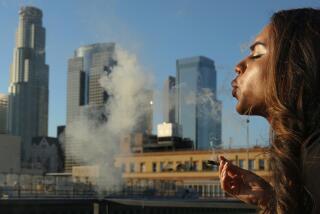‘A Drinking Club for Those With a Running Problem’
- Share via
MONROEVILLE, Pa. — In a shopping center parking lot, the Duke of Hurl shakes a handful of peach-colored flour on the ground, creating a dot, an “X,” an “F,” an arrow and a “B.”
He explains their meaning for the three dozen runners -- “hounds” -- gathered for the Pittsburgh Hash House Harriers weekly romp. Duke is the “hare” and has previously sprinkled the symbols along nearby roads, a railroad bed and through woods. The hounds must follow the symbols as they traverse a course of several miles.
The goal, if you choose to call it that, is beer. Welcome to hashing, an international phenomenon that’s jokingly described as “a drinking club for those with a running problem.”
Dots mean the hounds are on the right trail; once spotted, the lead hounds shout, “On, on!” to guide those in the rear.
An X means the trail could go in any of several directions, only one of which is right. The hounds usually split to find the right trail. The wrong trail will lead to an F, for false.
An arrow also means the hounds are on the right track, and the B is for beer break, when the hounds stop for a drink and a chat before hitting the trail again for the run to the finish.
Hashing traces its origins to the late 1930s, when the British occupied Malaysia and a group of runners modified the old English school game of hares and hounds.
The story goes that a group of expatriates looking to hasten their hangover recovery from the weekends met on a Monday to run it off.
An enterprising pub owner started meeting them at the end of their runs with beer in his car trunk, which gave birth to the idea of combining the two activities, according to Jay “Hops” Hopkins, editor of Half-Mind Catalog, an Internet hashing magazine.
There are two types of hashes: dead hare and live hare. In dead hare, the more common type of hash, the hare sets the trail ahead of time. In live hare, the hare sets out just before the hounds.
Kennels, as the clubs are known, go by either a nickname or their geographic location, which is tacked onto “Hash House Harriers.” Hash house was the original runners’ nickname for the Selangor Club in Kuala Lumpur where many ate and lived.
Although beer figures strongly in hashing, alternative beverages are available for teetotalers; camaraderie is the real reason behind hashing.
“The camaraderie can be so bonding and so tightknit that it becomes not just something to do but something that you would not dream of missing,” said Hopkins, who works in public relations in the Washington area and met his wife through hashing.
Athleticism isn’t a requirement, but determination is. One hasher proudly boasts that hashers are fiercely noncompetitive. Body types at the Monroeville hash ranged from lithe to Rubenesque.
“We call it the running club for the fit, the unfit and the misfits,” said Emil “Noah” Neufeld of Pittsburgh, who has been hashing here since 1981.
There’s no award for finishing first and, at least in the Pittsburgh kennel, no punishment for finishing last. Some kennels require that the last hound set the next hash.
Hashing has a number of traditions that may vary from one kennel to the next, said Tim Minard, 44, of Mount Lebanon, a draftsman for the Pennsylvania Department of Transportation who’s been hashing for four years.
In the Pittsburgh kennel, every hasher has a nickname -- often lewd and sophomoric -- and members frequently don’t know other members’ true names. That allows runners the opportunity to blow off steam in a nonjudgmental setting.
The Duke of Hurl is a teacher and refused to disclose his name because he worries that his school might not look favorably upon hashing.
Tights are a smart choice to wear to a hash because they help protect against scratches. Wearing new running shoes to a hash is punishable by having to drink a beer (known as a “down-down”) from the shoe after the run. Bragging about a good finish is also punishable by a down-down.
After a hash, runners usually meet at a bar for what is known as the apres (as in apres-ski). They sing bawdy songs, discuss the quality of the hash and, of course, consume beer.
“Half of the fun of hashing is being separate from the everyday situation,” said Jim “Moon” Martin, 57, a longtime hasher from Pittsburgh.
About 70 to 80 people belong to the Pittsburgh kennel and about half that many can be counted on for its runs, which are held year-round.
“Every week we do it,” Minard said. “Rain or shine, we don’t cancel it. I don’t miss it. I’d miss my own funeral first.”
There are more than 300 kennels in the U.S.; Wyoming appears to be the only state that doesn’t have at least one active kennel. But hashing doesn’t have the prominence here that it does in other parts of the world.
In Malaysia, “the hash there is revered as a native sport,” Hopkins said.
More to Read
Sign up for Essential California
The most important California stories and recommendations in your inbox every morning.
You may occasionally receive promotional content from the Los Angeles Times.













